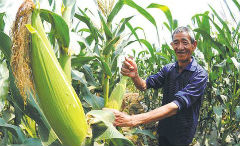Hainan cultivating high-tech agriculture
2018-04-06
China Daily
Hainan province is increasingly working to hasten agricultural supply side structural reforms, speed up the development of the sector’s modernization and strengthen tropical agriculture.
Before it was upgraded to a province in 1988, about 80 percent of its grain and animal husbandry products was supplied from outside. But it is now becoming the country’s biggest fruit and vegetable producer in the winter, contributing 4.8 million metric tons of vegetables to the domestic market last year.
A total of 430 tons of litchee, longan, mango, pawpaw and green oranges were exported from Hainan to Canada, the United Kingdom and the United States last year, while another 960 tons of fresh vegetables were sold to Hong Kong, according to official statistics.
Xu Yun, director of the Hainan provincial department of agriculture, said the province is restructuring its agricultural sector by reducing low-efficiency industries and products such as sugar cane and eucalyptus. Instead, it is expanding higher quality produce varieties such as winter vegetables and melons, sweet potatoes, pineapples, grapefruits and cherry tomatoes.
Chengmai, about 60 kilometers from the provincial capital of Haikou, is one of the regions that has reaped benefits from restructuring local farming. “Our Qiaotou brand sweet potatoes sell well in Beijing and Shanghai, as well as markets in Japan and Canada,” said Wang Wenke, head of Changtang village in Qiaotou town, Chengmai — an area known for its rich soil and the longevity of its locals.
The 40-year-old village head made a living in cities after graduating from a university in Nanjing, and then returned to Changtang, his home village, in 2007. At the time he convinced his fellow villagers to try cultivating sweet potatoes instead of the traditional lower-profit rice.
Sweet potato fields have expanded to 1,800 hectares in Qiaotou, a town of 22,000 residents, and a research institute developing virus-free seedlings there is helping promote better farming practices. Output value from sweet potato harvesting reached 360 million yuan ($57 million) last year. About 310,000 tourists visited Qiaotou in 2017 to enjoy digging up sweet potatoes for themselves last year.
The Qiaotou model of introducing high-efficiency farming is being copied across the island.
Dongfang, on Hainan’s southwest coast, now has large fields of red flesh dragon fruit and white chrysanthemums after converting wasteland into farmland. Its export of winter white chrysanthemums accounts for over half of the country’s total and is growing at 20 percent a year.
The 733-hectare Lingshui modern agriculture demonstration zone on the east coast, launched in 2015, has played an active role in showcasing the importance of technology in farming. A vertical farming system introduced from Singapore can now produce 27.5 tons of vegetables per mu (0.066 hectare) a year versus output from traditional farming of just 4 tons.
Xu, the agricultural official, said Hainan will accelerate agricultural standardization to realize comprehensive high efficiency production. It will cultivate 30 leading sectors in planting, aquaculture and processing while developing 30 key products to upgrade the competitiveness of quality Hainan farm produce.


